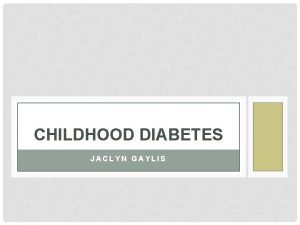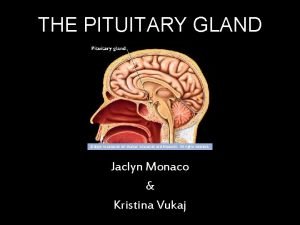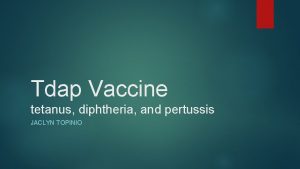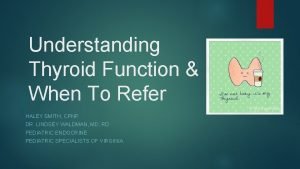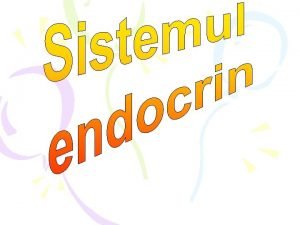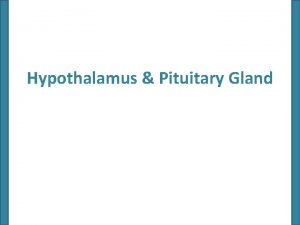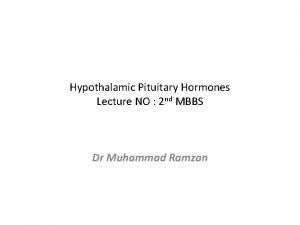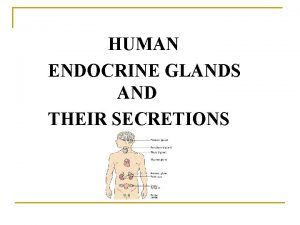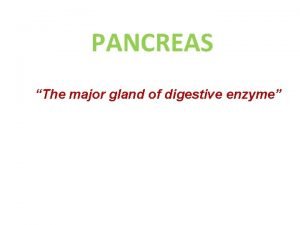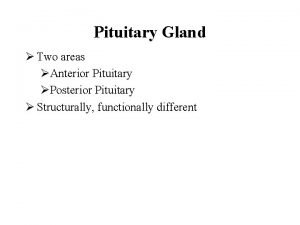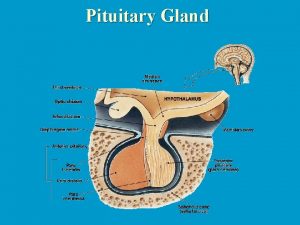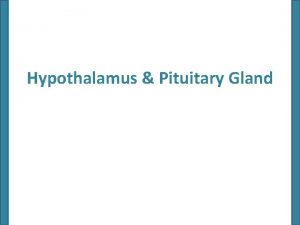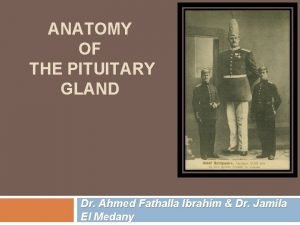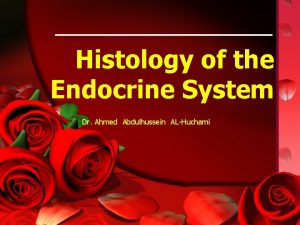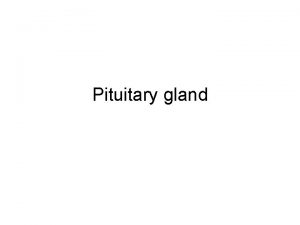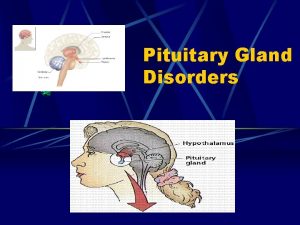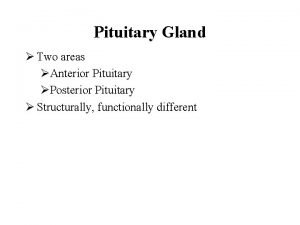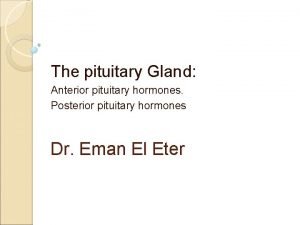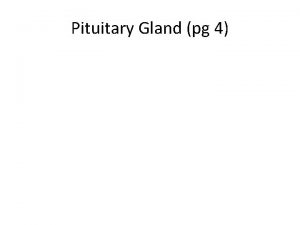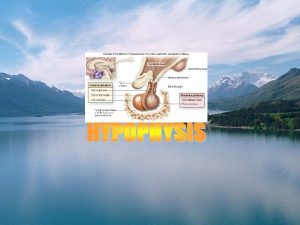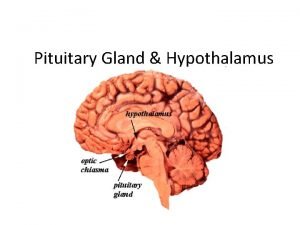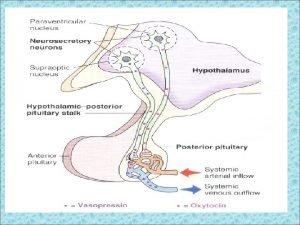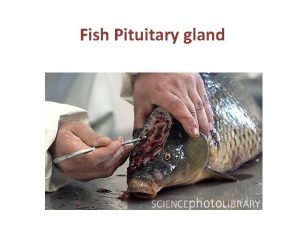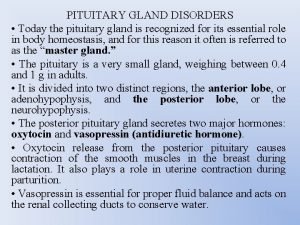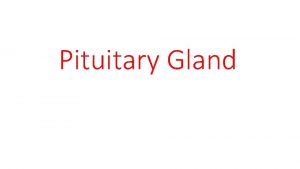THE PITUITARY GLAND Jaclyn Monaco Kristina Vukaj The


















- Slides: 18

THE PITUITARY GLAND Jaclyn Monaco & Kristina Vukaj

The Pituitary Gland Is In Your Brain It is also known as the Hypophysis!

The Pituitary Gland Is… • the size of a pea! • behind the bridge of the nose, between the optic nerves. • found in a bony hollow beneath the base of the brain, in the sella turcica, and beneath the hypothalamus. • divided into two major lobes, the anterior lobe and the posterior lobe.

Chemical Activity Let’s Talk Hormones: The different lobes of the pituitary gland produce entirely different hormones. The hormones have an impact on all of the other glands of the body. POSTERIOR LOBE 1. Oxytocin 2. Anti-diuretic hormone ANTERIOR LOBE 1. Growth hormone 2. Luteinizing hormone 3. Adrenocorticotrophic hormone 4. Prolactin 5. Follicle stimulating hormone 6. Thyroid stimulating hormone

What do these hormones regulate? • Growth • Breast milk production • Contractions during birth • Water retention/removal by the kidneys • Egg production by the ovaries • Stress hormone production by the adrenal glands • Activity of the thyroid gland

Facts about hormones: • All anterior pituitary hormones are proteins, that act through secondary messenger systems and are regulated, in most cases, by negative feedback. • The prolactin and growth hormones exert their major effects on nonendocrine targets. • The remaining four are tropic hormones which stimulate their endocrine gland targets to secrete their hormones, which in effect will stimulate other body organs and tissues. • THIS IS WHY THE PITUITARY GLAND IS THE MASTER GLAND!!!

Molecular Make-Up • Anterior Lobe: GLANDULAR TISSUE – Types of cells: – 1) acidophils – 2) basophils – 3) chromophobes • Posterior Lobe: NERVOUS TISSUE

Functions of the Pituitary Gland (and its hormones!) • The major function of the pituitary gland is to secrete hormones. • HOWEVER, the activity of these hormones is what’s important because they affect multiple other parts of the body.

Anterior Lobe Hormone Functions: • Growth Hormone (GH): – Effects growth of skeletal muscles and long bones. – Causes amino acids to be built into proteins and stimulates target cells to grow and divide. – Causes fat to be broken down and used for energy. – Helps to maintain blood sugar homeostasis. • Prolactin (PRL): – Stimulates and maintains milk production by the mother’s breasts after childbirth. • Adrenocorticotropic Hormone (ACTH): – Regulates endocrine activity of adrenal cortex. • Thyroid Stimulating Hormone (AKA thyrotropic hormone) (TH): – Influences growth and activity of thyroid gland. • Gonadotropic Hormones: – Regulate the hormonal activity of the gonads (ovaries and testes). • Follicle Stimulating Hormone (FSH): – Stimulates follicle development in ovaries in women. As they mature, they produce estrogen. – Stimulates sperm development by the testes in men. • Luteinizing Hormone (LH): – Triggers ovulation of an egg from the ovary in women. – Stimulates testosterone prudction by the interstitial cells of testes in men.

Posterior Lobe Hormone Functions: • The posterior lobe does not • Oxytocin: – Released in significant amounts create its own hormones. during childbirth and nursing in These two hormones are women. formed by the hypothalamus. • The posterior lobe acts as a storage area for these hormones. – Stimulates powerful contractions of the uterine muscle. – Causes milk ejection (“let-down reflex”) during nursing. • Anti-diuretic Hormone (ADH): (diuresis = urine production) – Inhibits or prevents urine production. – Causes kidneys to reabsorb more water from urine. • Urine volume decreases; blood volume increases. – Increases blood pressure (in large amounts).

Pituitary Gland= MASTER GLAND: • Pituitary. Hypothalamus Relationship: – Pituitary gland controls activity of many other endocrine glands – Its removal or destruction would cause the adrenal glands and thyroid glands and gonads atrophy – Release of hormones is controlled by the releasing and inhibiting of hormones produced by the hypothalamus. – The hypothalamus releases these regulatory hormones into the blood of a portal circulation (two capillary beds connected by veins) which connects the blood of the hypothalamus with the blood of the anterior pituitary.

What if something goes wrong? • Pituitary Tumors: – When the cells that make up the pituitary gland grow too much or create small growths. – Interfere with the normal production and release of hormones. – Common in adults. • Two types of tumors: Secretory & Non-Secretory – Secretory= produce too much of a hormone. – Non-Secretory= large size interferes with normal functions of the gland. • The consequences include: – Hypersecretion= over-production of any hormone. – Hyposecretion= under-production of hormones (usually caused by non-secretory tumor). – Tumor mass effects= as a tumor grows and presses against the gland other parts of the brain, head aches, vision problems, or other health issues may occur.

Specifically: • Cushing’s Disease: – A secretory tumor associated with the hypersecretion of ACTH, causing too much cortisol by the adrenals. – Affects 4, 000+ people in the U. S. per year. – Symptoms include: • Muscle weakness • Purple stretch marks • Rapid weight gain • Memory loss • Menstrual cycle disorders • Skin changes & red cheeks • Depression • High blood sugar/pressure – Treatment= personalized, but may include medication, surgery, and radiation. • Non-functioning Adenoma: – A non-secretory tumor often associated with head injury. – May cause headaches and vision problems and also hyposecretion. – Symptoms/Effects: • • • Loss of appetite Weight loss/gain Fatigue Irregular menstrual cycle Infertility Frequent urination at night Joint pains Dizziness Low blood pressure – Treatment may include transsphenoidal microsurgery through the nasal sinuses, hormone replacement, or radiation.

Molecular Images: • Slides A-C: normal pituitary obtained at autopsy. • Slides D-F: pituitary adenoma in Cushing disease.

Pituitary Tumor Images • Image 1: MRI image showing a large nonfunctioning pituitary macroadenoma • Image 2: illustrated image of pituitary tumor.

Gigantism and Dwarfism…YES they are diseases! • Hyposecretion of GH in childhood= pituitary dwarfism. – Although body proportions are fairly normal, the person as a whole is a living miniature (Max adult height= 4 ft) • Hypersecretion of GH in childhood= Gigantism – 8 to 9 ft is usual. Most usually caused by tumors of affected gland, which begin to secrete hormones like the normal glandular cells do. • If hypersecretion occurs after long bone growth has ended (how can we tell? ? ): – Acromegaly= Facial bones including lower jaw and bony ridges under eyebrows and also feet and hands, enlarge tremendously. – Malformed facial features because of thickening of soft tissues. • **Today, pharmacological doses of GH are used to reverse some of effects of aging. Although it is proven to help children with dwarfism grow normally, help stop the aging process, and even help prevent AIDS patients from dying, when abused, GH can be fatal. – This is what you hear about on the news when all the baseball players are taking dangerous STEROIDS!

Dwarfism & Gigantism Images:

• SOURCES: http: //2. bp. blogspot. com/_8 Dln 2 xk. R 7 y 8/SEobigkn. Uc. I/AAAAA • • Mc/Lrg. Nc. Ex. Iywg/s 400/mayo+pituitary+gland. jpg www. enotes. com/nursing-encyclopedia/pituitary-gland http: //www. webhealth. co. uk/a_to_z_of_health/pituitary. asp http: //www. suite 101. com/content/the-pituitary-gland-a 68589 http: //www. encyclopedia. com/topic/pituitary_gland. aspx http: //www. answers. com/topic/pituitary-gland http: //www. thehormoneshop. com/pituitarygland. htm http: //www. ajmc. com/media/image/A 102_04 S 424_F 2. gif http: //www. hormone. org/Pituitary/overview. cfm • http: //instruction. cvhs. okstate. edu/histologyreference/hrendo. htm • ANATOMY TEXTBOOK
 Thyoid gland
Thyoid gland Pituitary gland and pineal gland spiritual
Pituitary gland and pineal gland spiritual Kelly goudreau
Kelly goudreau Kristina vukaj age
Kristina vukaj age Kristina vukaj
Kristina vukaj Kristina vukaj
Kristina vukaj Hashitoxicosis
Hashitoxicosis Hormoni hidrosolubili
Hormoni hidrosolubili Hypothalamus and pituitary gland connection
Hypothalamus and pituitary gland connection Division of pituitary gland
Division of pituitary gland Triple f gland for flight fright and fight is
Triple f gland for flight fright and fight is Posterior abdominal wall nerves
Posterior abdominal wall nerves Exocrine glands function
Exocrine glands function Structure of hypothalamus and pituitary gland
Structure of hypothalamus and pituitary gland Anterior pituitary
Anterior pituitary Amiformes
Amiformes Hypothalamus hormones
Hypothalamus hormones Anatomical relations of pituitary gland
Anatomical relations of pituitary gland Dictalie
Dictalie



